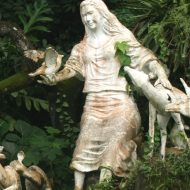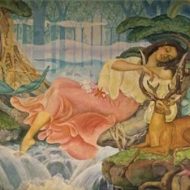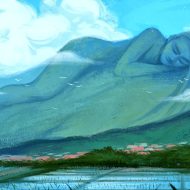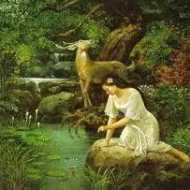Maria Makiling : The Guardian Spirit
At a glance
| Description | |
|---|---|
| Origin | Philippine Mythology |
| Classification | Spirits |
| Family Members | N/A |
| Region | Philippines |
| Associated With | Mount Makiling, Nature, Forests |
Maria Makiling
Introduction
In Philippine mythology, Mariang Makiling, affectionately known as Maria Makiling, holds a place of reverence and significance. Her legend is intrinsically tied to the picturesque Mount Makiling in Laguna, Philippines, and she is revered as one of the most widely recognized diwatas (anitos) in Philippine folklore. Through the ages, the enchanting tale of Maria Makiling has been lovingly handed down from one generation to the next, captivating the hearts and minds of Filipinos and visitors alike. Within its captivating narrative, this folklore intertwines the elements of love, betrayal, and the enduring spirit of a woman whose name has become synonymous with the mystique of the Philippines.
Physical Traits
The enduring legend of Maria Makiling continues to enchant the souls of both Filipinos and visitors. The iconic image of a captivating woman with cascading hair and a pristine white gown stands as a symbol of the enchanting allure and the steadfast guardianship of the Philippines’ pristine natural beauty. Many locals claim to have seen her on the slopes of Mount Makiling, particularly during times of mist or fog, and believe that she takes the form of a white butterfly. In the legend, she is described as having long flowing hair, a white gown, and an otherworldly presence.
Family
The legend of Maria Makiling is a love story at its core. It tells the tale of a captivating, ethereal woman named Maria, who was said to be the daughter of a tribal chieftain. With her unparalleled beauty and grace, Maria easily captured the hearts of the local men, but she had eyes for only one – a handsome young hunter named Juan. Maria and Juan’s love was the stuff of dreams, transcending earthly limitations, and symbolizing the deep connection between the people and the land. Their love was a testament to the profound bond Filipinos have with their natural surroundings.
However, as with many legends, tragedy befell the young lovers. A neighboring tribe invaded Maria’s village, and in the ensuing conflict, Juan was mortally wounded. Heartbroken and desperate, Maria’s profound love for Juan transformed her into a mystical guardian spirit. Maria Makiling, now a mystical entity, took it upon herself to protect the land and its people. She was believed to be both benevolent and vengeful, offering guidance and protection to those who respected the land but punishing those who harmed it.
Other names
The appellation “Mariang Makiling” is a fusion of Spanish and Tagalog, derived from “Maria ng Makiling,” signifying “Maria of Makiling.” This name is an assimilation that evolved under Hispanic influence from an alternative title for the Diwata, “Dayang Makiling.” “Dayang” is rooted in Austronesian, denoting a “princess” or a “noble lady.” In the era preceding the conversion of the indigenous populace to Christianity, Maria Makiling was already recognized as Makiling, an anito dispatched by Bathala to assist humanity with their daily undertakings from the majestic confines of Mount Makiling.
Powers and Abilities
In the pre-colonial Philippines, Maria Makiling was revered as a deity known by the names Dayang Masalanta or Dian Masalanta. She held a sacred place in the hearts of the people, as she was called upon to intercede and quell deluges, tempests, and seismic disturbances. Her role as the guardian spirit of Mount Makiling made her the steward of its abundant resources, bestowing her blessings upon the local communities that depended on the mountain’s gifts.
Not limited to her protective role over the mountain, some legends extended Maria Makiling’s dominion to include Laguna de Bay and the bountiful fish teeming within its waters. According to the lore, she was dispatched by Bathala to assist the residents of the region in their daily lives, showcasing her benevolent nature.
Mount Makiling, in a remarkable twist of nature, takes on the silhouette of a woman, often said to be the very likeness of Maria herself. This peculiar phenomenon is confirmed from various vantage points, dispelling any notion of a single specific location where this resemblance is observed. The mountain’s numerous peaks are said to correspond to Maria’s facial features and her two bosoms, while her tresses gracefully cascade down a gentle slope, mirroring the flow of her spirit away from her earthly form.
Modern Day Influence
Contemporary accounts of Maria Makiling persist to this day. Many have reported encountering her seated upon a riverbank’s rock, seemingly lost in contemplation as the tranquil waters flow by. On nights of crystal clarity, local residents attest to hearing the mellifluous notes of a harp, accompanied by a hauntingly beautiful voice, serenading the night with enigmatic and melancholic melodies.
For over six generations of Tagalog people, Mariang Makiling has held a cherished role as a guardian spirit. She is believed to undertake the arduous task of restoring the damage wrought by storms and typhoons, mending fractured tree trunks, returning fallen nests to their lofty perches, tending to wounded butterfly wings, clearing the entrances of anthills, and cleansing the rivers of their debris, including fallen branches and tree trunks.
The legend of Maria Makiling finds expression in a myriad of art forms, encompassing literature, theater, visual arts, and music. Countless compositions of songs, verses, and even cinematic productions have drawn inspiration from this enduring tale, each offering a distinct interpretation of her narrative. Mount Makiling, itself a symbol of natural beauty and wonder, has become a sought-after destination for hikers and nature enthusiasts, who embark on journeys with the hope of catching a glimpse of Maria or her ethereal white butterfly form.
Related Images
Frequently Asked Questions
What is the story behind Maria Makiling?
Why did Maria Makiling disappear?
What is the moral lesson of the story of Maria Makiling?
Is Maria Makiling a fairy?
Is Mount Makiling still active?
Mount Makiling is classified as inactive by the Philippine Institute of Volcanology and Seismology (PHIVOLCS). However, it does show signs of past volcanic activity through geothermal features like mud springs and hot springs. There are even geothermal power plants nearby. So while not currently erupting, it’s technically considered potentially active.















